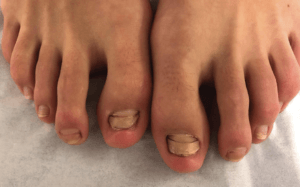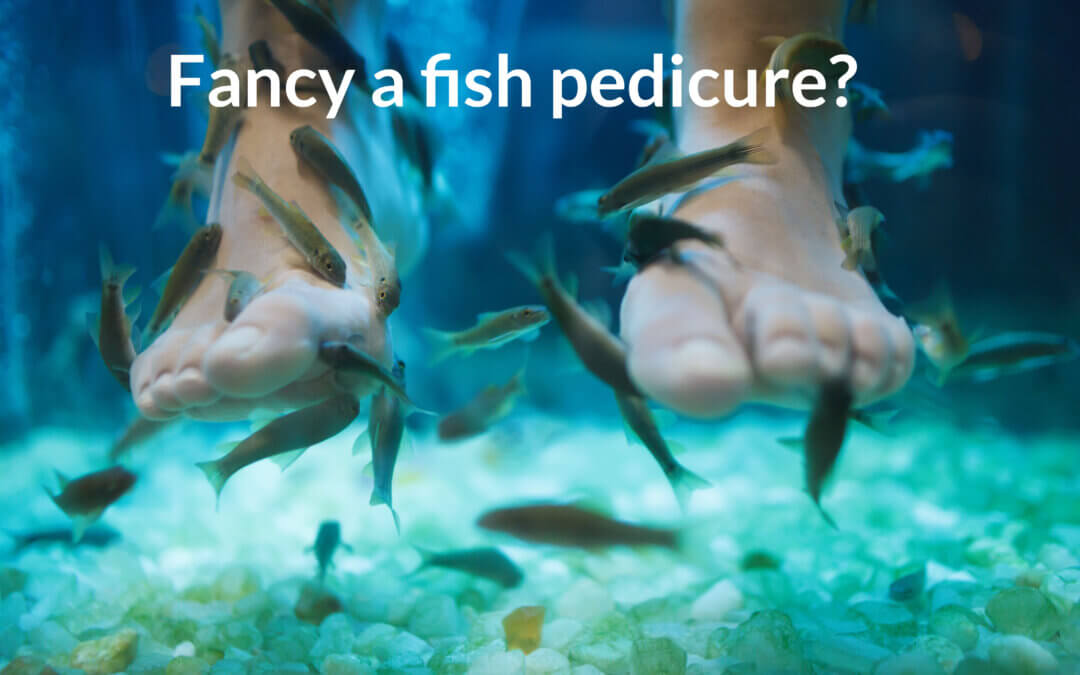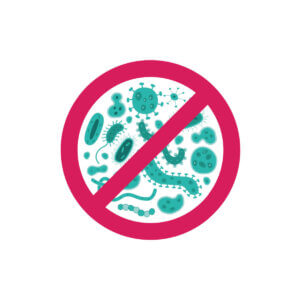Ichthyotherapy
There are two questions. Do fish pedicures pose a risk, and why should we not use them? For the clinician, the microbes discussed are of greater value, although limited to elementary descriptions in this article shared with the public.
For avid viewers of Doc Martin, the British comedy series set in beautiful Cornwall’s Port Isaac is always a delight, although somewhat utopic in the swift cure and diagnosis provided by the ex-surgeon and haemophic local GP Martin Ellingham. Series (10), records Dr Ellingham’s acerbic reaction to Janice, the local beautician’s use of fish pedicure after she goes down with a sickness.
While countries like the USA have banned foot spa pedicures in several states and Canada, the UK does not have a ban in place, only health and safety guidelines. NICE, the national institute for clinical excellence, has no provision or guide.
A survey in 2011 identified 279 fish spas in the United Kingdom (Verner-Jeffreys, 2012). Undertaking a quick Google search found centres spread across the UK that advertise a fish pedicure. However, the locations do not appear to be numerous. Health scares doubtlessly force shops to close, as was found in the Saddlers Centre in Walsall in 2011 – reported by the Express and Star newspaper.

Oct. 26 2011
A limited number of infections after fish pedicures have been reported in the United Kingdom. Unfortunately, little is known about the types of bacteria and other potential pathogens that might be carried by these fish and the potential risks that they might pose to customers or to ornamental and native fish.
CFP decided to look into this topic further and found some interesting facts. Yes, you can become infected from the doctor fish, as they are sometimes called, although the fish as Garra rufa fish and are found in the Middle East, such as Turkey, Syria, Iraq, Iran, the Far East – Indonesia. The Garra rufa belongs to the carp family. In their natural habitat, their suction helps them stick to rocks so they feed on plankton. In a town called Kangal, it was observed that the resident Garra rufa fed spared normal skin but ate psoriatic plaques. Let’s look at risk and potential reasons for scaremongering. Secondly, we need to feature the Garra Rufa fish.
What Are the Risks – Zoonotic infections
The Centre for Disease Control (USA) points out that fish deposit their waste in the water. This is true for humans in swimming pools, but of course, you cannot treat the water in a pedicure tank full of live organisms. The first point is you cannot fully sanitise the tank.
On April 12, 2011, the Fish Health Inspectorate investigated a report of a disease outbreak among 6,000 G. rufa fish from Indonesia that had been supplied to UK pedicure spas. Affected fish showed clinical signs of exophthalmia and of haemorrhage around the gills, mouth, and abdomen. More than 95% of the fish died before the remaining fish were euthanized. Histopathologic examinations identified systemic bacterial infections with small gram-positive cocci, mostly in the kidneys, spleen, and liver. Bacterial isolates cultured from affected fish were identified as Streptococcus agalactiae (group B Streptococcus) according to a combination of biochemical test results (API Strep; bioMérieux, Marcy l’Étoile, France), Lancefield grouping with serotype B (Oxoid Limited, Basingstoke, UK), and molecular (partial 16S rRNA gene sequencing) testing methods.
So, what type of bugs are we concerned about?
There are several strains of bacteria. These single-cell organisms are larger than viruses and produce products that can cause harm. Streptococcus agalactiae (Group B Streptococcus), is a bacterium that can cause pneumonia and serious infections of the bones, joints and blood. Vibrio cholorae and S. agalactiae — are strains resistant to many antimicrobial medications.
Mycobacterium marinum has been reported. In the latter case, a 21-year-old experienced infection following a pedicure in Thailand (Vanhooteghem et al. 2017).
“A skin infection may present as a solitary violaceous or red plaque or nodule. The nodular surface can be crusted or verrucous. The nodule may appear inflammatory and may have pus. M. marinum should be in the differential diagnosis of poorly healing nodular lesions not responding to antibiotics in the upper extremities. Based upon exposure to M. marinum, skin lesions can also be present in the lower extremities. M. marinum infections in non-HIV immunocompromised hosts as well.” Akram SM, 2022
Group B streptococcus (GBS) is a harmless, usually colonizing the gastrointestinal tract and genitourinary tract of up to 30% of healthy human adults GBS can cause severe invasive infections in newborns, the elderly, and people with compromised immune systems. Serious life-threatening invasive GBS infections are recognised in patients compromised by underlying diseases such as diabetes, liver cirrhosis and cancer. Adult infections include urinary tract infections, skin and soft-tissue infections, bacteraemia, bone infection, meningitis and heart inflammation leading to high mortality.
Staphylococcus aureus is one of the more common gram-positive bacteria aerobe found on the skin and in respiratory tracts and produces white pus in wounds common in cuts inappropriately managed. Early local treatment is adequate unless it spreads into the blood but should never be ignored.
Vibrio cholerae is a species of anaerobe, meaning it does not require oxygen. It lives naturally in salty and attaches itself easily to shells of crabs, shrimps, and other shellfish. Some strains of V. cholerae are pathogenic to humans and cause the deadly disease cholera. Cholera has not been reported, but Ellingham’s patient with tummy upset might be unrealistic if certain conditions arise. Coliforms such as E.coli and Pseudomonas have been cited as other organisms associated with risk.
The skin provides a viable barrier to most organisms that do harm. At the skin level, we can fight infection even before going deeper. However, we cannot see small openings from cuts or minor breaches. Where open wounds exist, or treatment for skin problems such as warts is being undertaken, the risk increases. Passing on or receiving an infection through a water medium kept at a warm temperature and using convectors such as the Garra Rufa is a notable risk.
Veraldi, in their abstract in 2014 (Staphylococcus aureus infection of the feet following fish pedicure), reported the following
“We report a case of Staphylococcus aureus infection of the feet that appeared after a “fish pedicure” (immersion of the feet in a tank with the fish Garra rufa, that nibbles off dead skin). Clinical picture was characterized by maceration, purulent discharge, scales, crusts, itching and burning sensation. Bacteriological examinations were positive for Staphylococcus aureus. Mycological examinations were negative. The patient was successfully treated with ciprofloxacin. Only one case of skin foot infection after fish pedicure was reported so far. Fish pedicure can be a potentially dangerous procedure in immunocompromised or diabetic patients.”

Onychomadesis of the Bilateral First, Second, and Third ToenailsThe proximal nail plate is discontinuous with the distal nail plate. The bilateral great toenails also show the disappearing nail bed. The right third toenail shows leukonychia, which indicates trauma to this nail unit.
Nail damage
In another case, onychomadesis was reported. Onychomadesis, or defluvium unguium, causes the separation of the distal nail plate from the proximal nail portion. Beau’s lines arise, and the transverse groove is often associated with episodes of disease, infection and inflammatory conditions. Liner (2018) reported only one case. The above picture is c/o the American Medical Association accessed 22/10/22. JAMA Dermatol. 2018;154(9):1091-1092. doi:10.1001/jamadermatol.2018.1827 downloaded 26/10/22
Ecology and cruelty
The medical evidence is present, although not in substantial volume. The other aspect is being misled and missold. Imports of the wrong fish can certainly arise, and spa providers may be misled. The Chinese Chinchin fish look similar to Garra Rufa, but unlike the omnivore Garra without teeth, the Chinchin can draw blood, and infection is a greater risk through inoculation and carrier cross-infection. The Chin Chin fish grows as it matures and is larger than Garra rufa.
The Fish Health Inspectorate of the Centre for Environment, Fisheries & Aquaculture Science estimates that each week 15,000–20,000 G. rufa fish are imported from Indonesia and other countries in Asia into the United Kingdom through London Heathrow Airport (the main border inspection post for the import of live fish), Verner-Jeffreys, 2012.
The People for the Ethical Treatment of Animals (PETA) Foundation is a UK-based charity dedicated to establishing and protecting the rights of all animals. They report that Garra rufa are typically starved of plants and other aquatic material, so they are more enticed to eat dead human skin — a practice some consider animal cruelty. They may be overfished and exploited. There is no regulation, and anyone can import the fish; many of these animals fail to survive travelling inside plastic bags. Peta says, “Get a safe, healthy, cruelty-free pedicure from a willing human technician.”
What does the official guide 2011 have to say?
The Health and Safety at Work etc. Act 1974, and the Control of Substances Hazardous to Health (COSHH) Regulations 2002, both require operators to assess risks and put appropriate control measures in place to ensure the health and safety of employees and other persons. Health and safety enforcement officers have a range of powers to ensure compliance with the legislation.
Under the Animal Welfare Act 2006, fish spa operators have a legal duty of care32 for fish at their salons. Under this Act, an appointed inspector can take action if premises fail to comply with its requirements. Spa facilities offering fish pedicures for cosmetic purposes fall outside regulation by the Medicines and Healthcare products Regulatory Agency, even if medical claims are made for the treatment.
Spa providers can be shut down and must keep risk evidence and clearly document all procedures with appropriate staff training.These next paragraphs have been lifted directly from the 22-page document produced by the UK Health Protection Agency. The summary at the end does offer a guide to spa shops.
Clients should be provided with information about contra-indications before treatment. Advice on medical conditions that may increase the risk of infection or pose an infection risk to other clients. Leg waxing or shaving in the last 24 hours (micro-abrasions increase infection risk). Consent is implied in that spa clients are guided to sign a form confirming they have understood the information given and are not aware of any contraindications to treatment.
Pre-immersion foot examination: specific training on how to inspect feet should be provided by a suitably trained individual. This could be a podiatrist or a beauty therapist with a nationally recognised qualification in pedicure. Staff should document that a foot inspection has been carried out.
Hands should always be washed after contact with the water to prevent inadvertent hand-to-mouth transmission of any possible gastrointestinal pathogens. If there is visual evidence of blood, there are several actions that spa centres must follow. Advice from specialists in maintaining equipment is important, and equipment, including filters, should be cleaned and maintained according to the supplier or manufacturer’s advice.
Conclusion
As a podiatrist, I could not agree more with PETA that human intervention is better for these abused sea creatures. There are so many variables in terms of skin, damage, pathology, and unknown medical concerns that Spa centres should appreciate any infection of concern following a foot pedicure session with a living creature is hard to give assurances. While no one aims to remove someone’s living, it behoves beauty therapists to use products that are sustainable and do not suggest elements of cruelty. Those clients wishing to use a fish pedicure would be best aware of both the dangers and requirements in the UK. Of course, I could ring around and find a cost, but any readers still not convinced will find prices vary. One US site suggested anywhere from $45 – $100. I would suspect low prices imply less attention to detail so pay more for better assurity – hopefully! Faced with these facts, I would not elect to use such a spa, but again, I am not sure I would find the experience that pleasant anyway.
![]()
Akram SM, Aboobacker S. Mycobacterium Marinum. [Updated 2022 Oct 9]. In: StatPearls [Internet]. Treasure Island (FL): StatPearls Publishing; 2022 Jan-. Available from: https://www.ncbi.nlm.nih.gov/books/NBK441883/
Lipner SR. Onychomadesis Following a Fish Pedicure. JAMA Dermatol. 2018;154(9):1091–1092. doi:10.1001/jamadermatol.2018.1827
Nazzaro G, Germiniasi F, Veraldi S. Fish Pedicure: A Risky Aesthetic Treatment for Tourists. J Am Podiatr Med Assoc. 2020 Sep 1;110(5):Article_19. doi: 10.7547/19-006. PMID: 33179070.
Vanhooteghem O, Theate I. Fish pedicure-induced foot mycobacteriosis infection due to Mycobacterium marinum: a first case report. Eur J Dermatol. 2017 Jun 1;27(3):299-300. doi: 10.1684/ejd.2017.2976. PMID: 28677579.
Veraldi S, Nazzaro G, Çuka E. Staphylococcus aureus infection of the feet following fish pedicure. Infection. 2014 Oct;42(5):925-6. doi: 10.1007/s15010-014-0622-4. Epub 2014 Apr 26. PMID: 24771416.
Verner-Jeffreys DW, Baker-Austin C, Pond MJ, Rimmer GS, Kerr R, Stone D, Griffin R, White P, Stinton N, Denham K, Leigh J, Jones N, Longshaw M, Feist SW. Zoonotic disease pathogens in fish used for pedicure. Emerg Infect Dis. 2012 Jun;18(6):1006-8. doi: 10.3201/eid1806.111782. PMID: 22608013; PMCID: PMC3358165.
Links used in this article
https://assets.publishing.service.gov.uk/government/uploads/system/uploads/attachment_data/file/322420/Fish_Spa_guidance.pdf
https://www.healthline.com/health/beauty-skin-care/fish-pedicure#takeaway
https://www.ncbi.nlm.nih.gov/pmc/articles/PMC3358165
https://jamanetwork.com/journals/jamadermatology/article-abstract/2686152
Thanks for reading ‘The Fish Pedicure – good or bad?’ by David R Tollafield.
Published by Busypencilcase Communications. Est. 2015 for ConsultingFootPain
CFP publishes regular articles on this site covering health & feet and welcomes topical items from all medical professionals and readers. David is a podiatrist and former consultant. Read more here.



Great study David, and couldn’t agree more regarding your concerns based on Peta info.
I wouldn’t venture to use one of these so called spas either, although I have to admit having my feet ‘nibbled’ by wild fish in a Cenote in Mexico was quite a calming pleasurable experience. Don’t knock it till you’ve tried it!
I’ve just got back from Majorca
With red sore feet from fish pedicure. Very sore to walk on. Is this dangerous?
Thanks, Bev, for your comment. Because we don’t know the fish involved and you have redness, I would seek advice from your GP surgery in case they want to consider treatment. Without a photo, it would be difficult to say if this was associated with another source. Best to be safe than sorry. If your GP surgery is delayed in seeing you, try using NHS Direct for advice or go to the local walk-in centre which would be faster. I have made an assumption you are from the UK. David